Steel Products
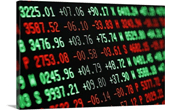
HRC Futures: Post Price Drop, Options for Buyers and Sellers
Written by Logan Davis
August 17, 2023
Over the last month, SMU columns have referenced significant fluctuations in the Hot Rolled Coil Futures market as participants sift through the impact of several events, including some that are yet to be resolved.
At the beginning of July, Steel Dynamics Inc.’s (SDI’s) Sinton, Texas, mill outage boosted prices before producers failed to achieve announced price targets, covered by Flack Global Metals’ Sean Kessler in SMU on July 27.
Jack Marshall of Crunch Risk on Aug. 3 wrote about the flattening curve and a decrease in open interest that often accompanies the uncertainty of market participants. The situation has muddied even further when labor negotiations began in Detroit last month.
Most recently, Dave Feldstein of Rock Trading Advisors wrote on Aug. 10 about market technicals and the looming risk of deteriorating Chinese economic data.
All of this has culminated in a soft futures market probing for a bottom. The CRU Index price has dropped over 20% since April while inventory levels have remained low. At the time of this writing, the December HRC futures price has fallen from $820 to $760 per ton since our last published column—nearly 15%. To echo our peers in recent weeks, uncertainty remains a common theme.
For Buyers
The magnitude of the move could warrant a futures position for many buyers, but if further downside is believed to be plausible, an alternative strategy might be an upside collar. An upside collar involves the simultaneous purchase of an at-the-money call and the sale of put below the market. The sale of the put reduces the initial cost of the strategy. Using theoretical pricing in December HRC options, buying the $780 call and selling the $680 put is expected to cost about $26 per ton or $520 per contract. The position would be susceptible to margin calls if the market continued to drop. While the position would lose money in the case of a market drop, a portion of those losses would be offset with cheaper raw material prices in the physical market.
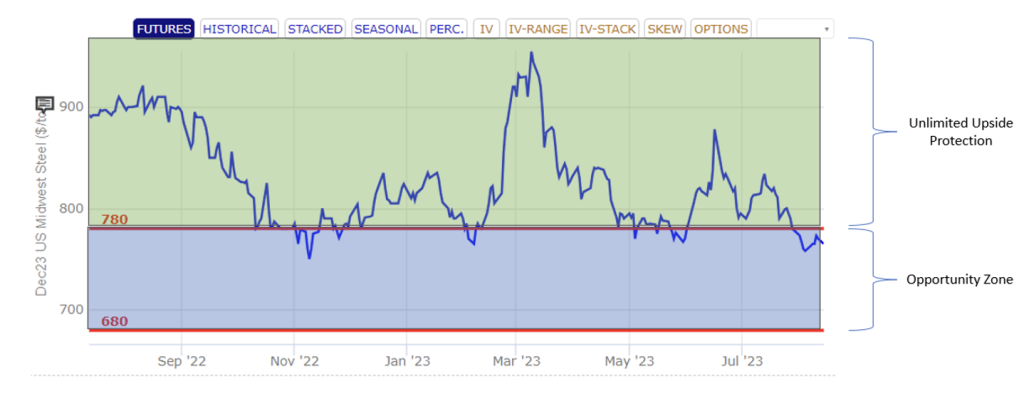
For Sellers
The move lower has understandably caused some stress for sellers in the industry. Adding downside protection after such a large downward move is not generally ‘Plan A.’ With further downside possible and the uncertainty mentioned above, however, a company may choose to mitigate further losses. One way to protect against a further decline, while allowing for unabated price recovery, is to buy a put spread. By purchasing a $760 put and selling a $680 put below the market, a company can effectively protect themselves to a range of lower prices. Like an outright put, this strategy provides a floor on price with unlimited upside and has no potential for margin call exposure. The $680 put sold below the market does limit the protection in the strategy but simultaneously reduces the overall premium cost. In total, the put spread outlined here would cost $32 per ton or $640 per contract. In contrast, the put alone would cost $48 per ton or $960 per contract.
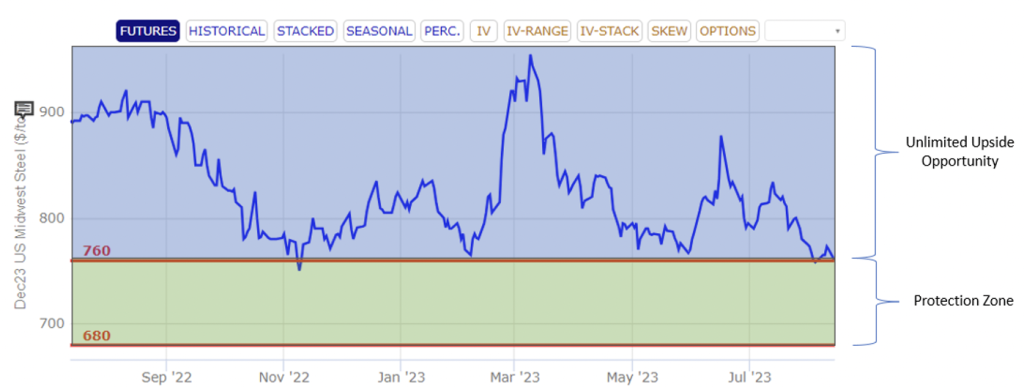
There is risk in futures and options trading. Each of the strategies described in this post carry different considerations:
- The upside collar would protect the buyer’s price at a higher rate than the put spread would protect the sellers.
- This is by design; the collar provides unlimited protection and a range of participation while the put spread yields protection to a price as it allows for unlimited participation.
- The collar exposes the trader to margin call risk (capital deposit requirement) while the maximum cost of the put spread is the net premium of the options.
- Offsetting either strategy before expiration will change the cost and P/L
When trading options, positions should be managed as the market changes and time passes.
Options pricing above based on theoretical values. There is a risk of loss in futures trading. Past performance is not indicative of future results. © 2023 Commodity & Ingredient Hedging, LLC. All rights reserved.

Logan Davis
Read more from Logan DavisLatest in Steel Products

Steel buyer spirits tempered by soft spot market conditions
Steel sheet buyers report feeling bogged down by the ongoing stresses of stagnant demand, news fatigue, tariff negotiations or implementation timelines, and persistent macroeconomic uncertainty.

CRU: US stainless prices to rise on expanded S232 tariffs
Stainless prices in the US market will rise, following price increases by major US producers. Our base case scenario incorporates higher US prices in the near term, despite the initial negative reaction by the market. US stainless prices will go up in 2025 H2 and will stay elevated in 2026 as tariffs on stainless […]
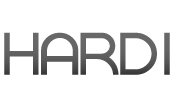
Galvanized steel demand unsteady amid lingering buyer fatigue: HARDI
Uneven demand for galvanized steel in June reflects a market that remains mired in uncertainty, according to industry sources.

OCTG industry salutes Customs for catching trade crooks
The US OCTG Manufacturers Association is commending US Customs for intercepting another Thai company's attempt to illegally transship Chinese oil pipe to the US.
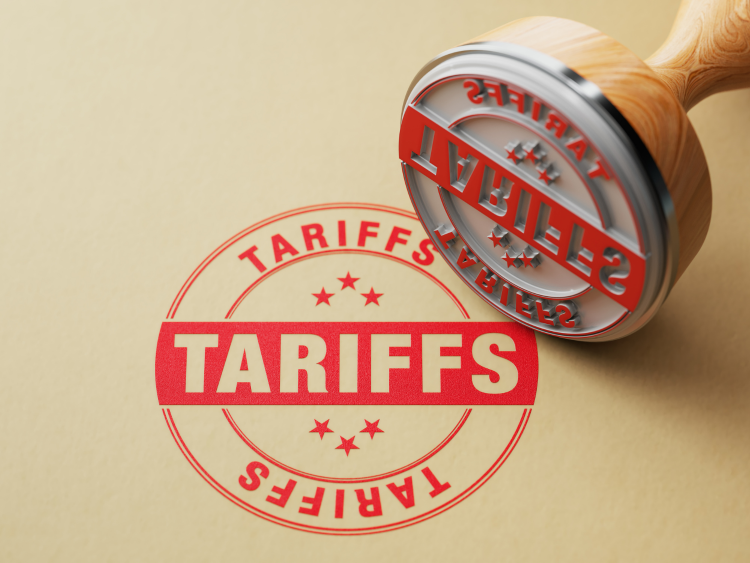
Whirlpool says tariffs will bolster business
“Economically, the business case for products made in the us has become a lot more attractive," the CEO told Fox Business.
